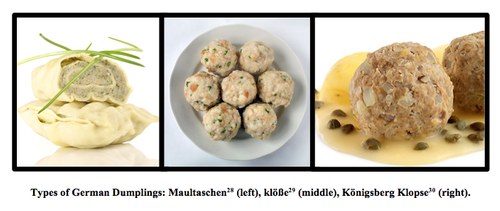The original klöße, flour-based dumplings, in Germany did not contain a filling or potatoes. The unique lump-like structure of these klöße dumplings in Germany and Scandinavia is quite distinct from that of other dumplings in the region, such as the German “maultaschen,” which is formed by folding thin dough17. One theory for the rapid emergence of the globular flour-based dumplings in Germany is that they developed in the late Middle Ages as a cheaper substitute for meat dumplings, such as the Königsberg klopse17. As shown below, the evident structural similarities between the German klöße and Königsberg klopse support this explanation. Similarly, these sorts of dumplings in Scandinavia may be related to the old, Swedish “Färsrulader,” a traditional meat-dumpling-like dish containing a filling of bacon, onions, or beats9. Following the introduction of the potato to Europe, the German “kartoffel klöße,” or potato dumpling, emerged in northern Germany13. Although the Scandinavian potato dumplings are clearly linked historically and etymologically to similar German dumplings, it is difficult to determine the stage in the evolution of these dumplings when they were introduced to Scandinavia from Germany.

